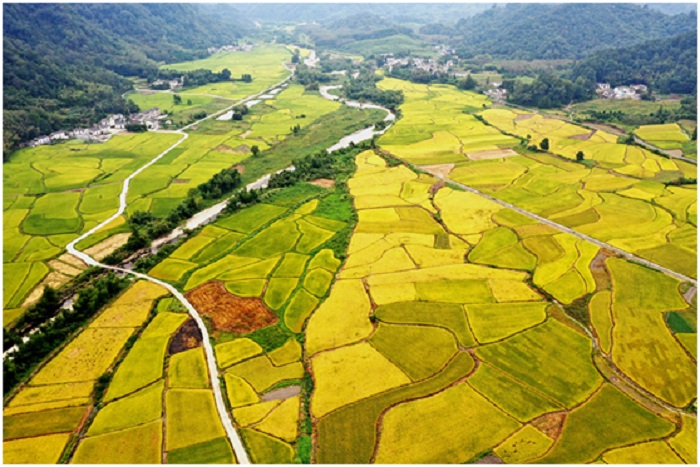



A new round of crayfish season has just started in many rice-crayfish fields in southern China.
In Duchang, Jiangxi, the rice-crayfish farming mode is bringing an net income of 3,000 yuan ($439) per mu (667 square meters) to local farmers. Compared with rice planting, the output of the mixed mode at least doubled. The rice-crayfish farming mode has already become a new path of poverty alleviation for local farmers.
China has a long history of fish-farming in rice fields. As early as more than 2,000 years ago, ancient Chinese had already been self-sufficient by planting rice and breeding fish in same fields. As one of the mixed rice-fishing farming mode, rice-crayfish farming is an important method for farmers to increase income, because it not only generates hundreds of kilograms of crayfish every mu, but also improves the quality of rice.
Compared with traditional rice planting, this mode is able to generate win-win results. The rice, which grows with the crayfish, needs no pesticides or fertilizer, and the crayfish in the rice paddies can loosen the soil and kill pests. Besides, the excrement of the crayfish also serves as natural fertilizer.
The rice grown in such a green manner is several times more expensive than traditional ones, and some are even priced at over 20 yuan per kilogram.
As rent, price of agricultural materials and labor charges rise in recent years, there’s a growth in the cost of crop plating. In a word, the rice-crayfish farming exactly mirrors the adjustment of grain production.
When traditional planting methods are seeing reduced profits and the market demanding more green and quality agricultural products, grain growers must change their farming mode.
Duchang, promoting the mode of rice-crayfish farming, has expanded the income channels for farmers and made the used-to-be low-output fields prosperous. It has achieved favorable results in both ecology and economy. More and more farmers are trying to mix husbandry with rice planting in their paddies.
The adjustment of agricultural production modes calls for appropriate means that suit local conditions. On one hand, supporting facilities are needed to bring the new modes into full play; on the other hand, adjustment needs to be made according to local climates and resources.
For instance, Anhui Province’s Lujiang is growing milk vetch, a kind of green manure, in rice paddies during winter, which has largely increased the organic content of the soil. Xinan village in Suihua, Heilongjiang Province has built a rice field theme park for both production and tourism.
On the production end, farmers must increase the value added of their products, reduce the usage of fertilizers and pesticides, and stretch the industrial line to promote the supply-side structural reform in the agricultural sector, and realize high-quality, high-profit, and sustainable development of agriculture.
The reason for the large promotion of mixed rice-fishing farming is that it not only enriches the side products in the rice fields, but also consolidates the basis for grain production and improves rice quality.
According to experts, crayfish and fish breeding in the rice fields is able to increase the leaf nitrogen content of the rice during tillering and pustulation periods. Besides, it also improves the ear bearing tiller rate of the rice.
In addition, abandoned farmlands are re-exploited in this mode, which effectively expanded the area of grain planting.


The Humanitarian Service Diamond Awards has.
A Chinese Company, Inner Galaxy Steel.


The Programme Coordinator, Regulatory, Compliance and.


A Non-Governmental Organization (NGO), Committee for.
The Trustfund Pensions Limited has chided.


The House of Representatives Committee on.
The China General Chamber of Commerce.


Senator Chuka Utazi who represented Enugu.


An Abuja based Legal Practitioner, Ugochukwu.


The African business community in Yiwu,.
Leave a Comment